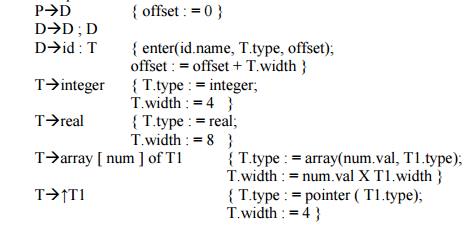Chapter: Principles of Compiler Design : Intermediate Code Generation
Declarations
DECLARATIONS
As the sequence of
declarations in a procedure or block is examined, we can lay out storage for
names local to the procedure. For each local name, we create a symbol-table
entry with information like the type and the relative address of the storage
for the name. The relative address consists of an offset from the base of the
static data area or the field for local data in an activation record.
Declarations in a Procedure:
The syntax of languages
such as C, Pascal and Fortran, allows all the declarations in
In the translation scheme shown below:
* Nonterminal
P generates a sequence of declarations of the form id : T.
* Before
the first declaration is considered, offset is set to 0. As each new name is
seen , that name is entered in the
symbol table with offset equal to the current value of offset, and offset is
incremented by the width of the data object denoted by that name.
* The
procedure enter( name, type, offset ) creates a symbol-table entry for name,
gives its type type and relative address offset in its data area.
* Attribute
type represents a type expression constructed from the basic types integer and
real by applying the type constructors pointer and array. If type expressions
are represented by graphs, then attribute type might be a pointer to the node
representing a type expression.
* The
width of an array is obtained by multiplying the width of each element by the
number
of elements in the array. The width of each pointer is assumed to be 4.
Computing the types and relative addresses of
declared names

Keeping Track of Scope Information:
When a nested procedure
is seen, processing of declarations in the enclosing procedure is temporarily
suspended. This approach will be illustrated by adding semantic rules to the following
language:
P->D
D->D; D |id: T |proc id; D ; S
One possible
implementation of a symbol table is a linked list of entries for names. A new
symbol table is created when a procedure declaration D proc id D1;S is seen,
and entries for the declarations in D1 are created in the new table. The new
table points back to the symbol table of the enclosing procedure; the name
represented by id itself is local to the enclosing procedure. The only change
from the treatment of variable declarations is that the procedure enter is told
which symbol table to make an entry in.
For example, consider
the symbol tables for procedures readarray, exchange, and quicksort pointing back
to that for the containing procedure sort, consisting of the entire program.
Since partition is declared within quicksort, its table points to that of
quicksort.
The semantic rules are defined in terms
of the following operations:
1.
mktable(previous) creates a new symbol
table and returns a pointer to the new table. The argument previous points to a
previously created symbol table, presumably that for the enclosing procedure.
2. enter(table,
name, type, offset) creates a new entry for name name in the symbol table
pointed to by table. Again, enter places type type and relative address offset
in fields within the entry.
3.
addwidth(table, width) records the
cumulative width of all the entries in table in the header associated with this
symbol table.
4. enterproc(table,
name, newtable) creates a new entry for procedure name in the symbol table
pointed to by table. The argument newtable points to the symbol table for this
procedure name.
Syntax directed translation scheme for
nested procedures
P->M D { addwidth ( top( tblptr) ,
top (offset));
pop
(tblptr); pop (offset) }
M->ɛ { t : = mktable (nil);
push
(t,tblptr); push (0,offset) }
D->D1 ; D2
D->proc id ; N D1; S { t : = top
(tblptr);
addwidth
( t, top (offset));
pop
(tblptr); pop (offset);
enterproc
(top (tblptr), id.name, t) }
D->id : T { enter (top (tblptr),
id.name, T.type, top (offset));
top
(offset) := top (offset) + T.width }
N->ɛ { t := mktable (top (tblptr));
push
(t, tblptr); push (0,offset) }
* The
stack tblptr is used to contain pointers to the tables for sort, quicksort, and
partition when the declarations in partition are considered.
* The
top element of stack offset is the next available relative address for a local
of the current procedure.
* All
semantic actions in the subtrees for B and C ABC{actionA}
are done before actionA
at the end of the production occurs. Hence, the action associated with the
marker M is the first to be done.
The action for
nonterminal M initializes stack tblptr with a outermost scope, created by
operation mktable(nil). The action also pushes relative address 0 onto stack
offset. Similarly, the nonterminal N uses the operation mktable(top(tblptr)) to
create a new symbol table. The argument top(tblptr) gives the enclosing scope
for the new table. For each variable declaration id: T, an entry is created for
id in the current symbol table.
The top of stack offset
is incremented by T.width. When the action on the right side of D -> proc
id; ND1; S occurs, declarations generated
by D1 is on the top of stack offset; it is recorded using addwidth. Stacks
tblptr and offset are then popped. At this point, the name of the enclosed
procedure is entered into the symbol table of its enclosing procedure.
Related Topics